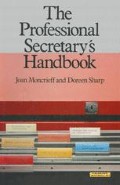Abstract
In a busy office communication is unceasing; from the moment the mail arrives and the telephone and telex operators come on duty information flows constantly in, out and sideways. Most incoming business communications belong to one of the following categories:
-
those requiring immediate action by the recipient
-
those to be passed on to someone for attention
-
those to be set aside until the right time for action
-
those to be filed away safely as part of a system of records.
The spoken word; typing and printing processes within the firm; external services in communications; telecommunications; effective selection; the personal touch
Access this chapter
Tax calculation will be finalised at checkout
Purchases are for personal use only
Preview
Unable to display preview. Download preview PDF.
Bibliography
John Markham: Successful Business Communication (Witherby and Co. Ltd., 1977).
Barry Maude: Communication at Work (Business Books Ltd., 1977).
I. A. Woolcott & W. R. Unwin: Communication for Business and Secretarial Students (Macmillan Ltd., 1977).
Copyright information
© 1980 Joan Moncrieff and Doreen Sharp
About this chapter
Cite this chapter
Moncrieff, J., Sharp, D. (1980). Effective Communication. In: The Professional Secretary’s Handbook. Palgrave Macmillan, London. https://doi.org/10.1007/978-1-349-16340-3_5
Download citation
DOI: https://doi.org/10.1007/978-1-349-16340-3_5
Publisher Name: Palgrave Macmillan, London
Print ISBN: 978-0-333-25720-3
Online ISBN: 978-1-349-16340-3
eBook Packages: Palgrave Business & Management CollectionBusiness and Management (R0)

